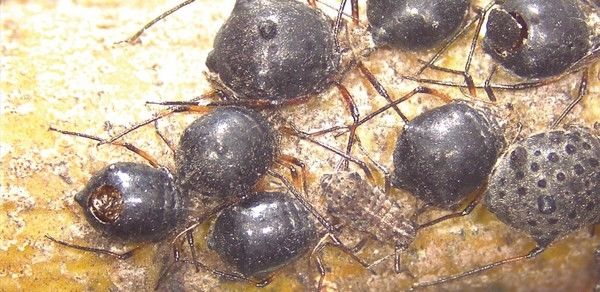A biological control agent for giant willow aphid has been identified and tested by Scion entomologists, approved and released in New Zealand.
Giant willow aphid (Tuberolachnus salignus), or GWA, was first reported in New Zealand in 2013. The aphids feed on willow sap, damaging and occasionally killing the trees. Willows are widely used in New Zealand for slope stabilisation, flood protection, crop and livestock shelter, fodder and as pollen and nectar sources for honeybees in early spring.
The aphids also secrete copious amounts of honeydew, which attracts insects such as honeybees and pest wasps. Honey made from the honeydew is granular and cannot be extracted from the comb, and bees are at risk of being killed by the wasps. Excess honey dew also causes sooty mould to grow on and beneath infested trees.
Biological control, where natural enemies control a pest, is a cost effective, sustainable and environmentally sound control method. While GWA has very few natural enemies in New Zealand, Scion scientists found evidence of parasitism in natural populations of GWA in California by the parasitoid wasp Pauesia nigrovaria. The parasitoid wasp lays an egg in the aphid, a larva hatches, and this then eats and eventually kills the aphid host as it develops. In two to three weeks a new adult parasitoid emerges from the dead aphid.
Stringent testing is needed before a biological control agent is released. The first parasitoids were imported into containment at Scion in 2017, followed by host specificity testing using non-target aphid species to ensure the parasitoid only attacked GWA. Following favourable results, an application to the Environmental Protection Authority was successful, with permission to release granted in December 2019.
Parasitoids wasps have been released by Scion and partners via a New Zealand-wide community effort. Scion shipped mated female parasitoids to beekeepers, regional council staff and others for release on infested trees.
Those involved in the releases, and citizen scientists, are now monitoring the successful survival and spread of the parasitoid. Not only did the tiny wasps overwinter, they have multiplied exponentially and spread up to 100 km from the first release sites. This is phenomenal - normally a biocontrol agent tends to disappear a few years while it settles in before signs of establishment are seen, followed by slow spread.
This work directly benefits beekeepers, river managers, soil conservationists and farmers. Indirectly, the general public will also benefit, for example, from river banks remaining less prone to erosion, fewer pest wasps and less sticky, sooty mould in public spaces.
“Scion has been working closely with the apiculture industry for more than five years on finding a biological control for the giant willow aphid, a destructive pest that has had a significant impact on willow trees and by extension the health of bees and honey production. Scion led extensive research into possible parasitoids of GWA and an application to government for the use of the insect Pauesia nigrovaria as a suitable biological control was strongly supported by Apiculture NZ. Scion’s work has been critical to addressing a serious problem for our industry and we are really pleased with the results of the release programme so far.” - Karin Kos, Chief Executive, Apiculture NZ
“I am hugely impressed with the work and dedication of the team at Scion for finding and successfully releasing a biological control for GWA. As a farmer relying on willows to secure our hill country, as the then Chair of the NZ Poplar & Willow Research Trust and in more recent times the Chair of Apiculture NZ, GWA was a real concern on many fronts. To now have a proven parasitoid wasp preying on these damaging pests is extremely welcome!” - Bruce Wills
Funders: Sustainable Food and Fibre Futures Fund, Strategic Science Investment Fund and co-funders
Collaborators: espri International, Regional Council River Managers Forum, NZ Honey Industry Trust, New Zealand Poplar & Willow Research Trust, Neil Barr Farm Forestry Foundation, Plant & Food Research, Apples & Pears NZ, Terra Preta Truffles (Australia), Roderick Cameron (Uruguay), Apiculture NZ – Gisborne, Waikato, Southern North Island, Bay of Plenty and Nelson Hubs, Trees for Bees, Wasp Tactical Group, Arataki Honey, Ingleby NZ LP, Manawa Honey, Golden Grove Apiaries, USDA Forest Service, University of Otago, Marin Municipal Water District (USA), Forestry and Forest Products Research Institute (Japan)

